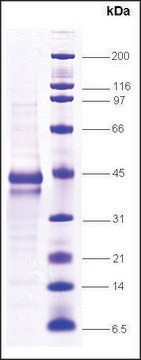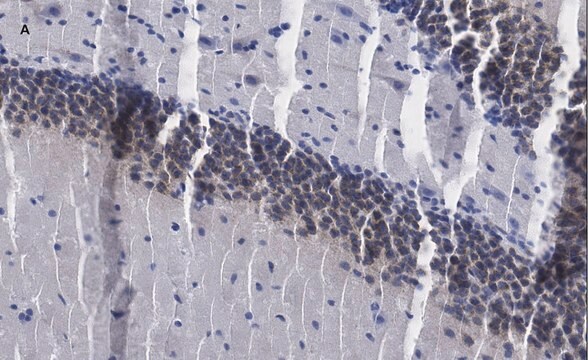추천 제품
생화학적/생리학적 작용
The transcription factor AP-1 (activator protein-1) is involved in cellular proliferation, transformation and death. AP-1 and nuclear factor B (NF B) can be specifically targeted to prevent cancer induction in mouse models. AP-1 can be produced by 18 different dimeric combinations of proteins from the Jun [c-Jun, JunB and JunD] and Fos (c-Fos, FosB, Fra-1 and Fra-2) families, including Jun homodimers and Jun-Fos heterodimers. The Jun and Fos proteins contain a basic-region leucine zipper (bZIP) domain, and are capable of binding to other bZIP proteins including those from the ATF, MAF, CNC and C/EBP (CCAAT/enhancer-binding protein) subfamilies. Jun-Jun and Jun-Fos dimers bind with highest affinity to the 12-O-tetradecanoylphorbol-13-acetate (TPA) response element (TRE) [TGA(C/G)TCA], although many other AP-1-like sites have been reported. Binding to any of these sites can be tissue-specific, or affected by neighboring sequences, and dependent upon interactions with other transcription factors or cofactors. Jun and Fos proteins can also dimerize with other bZIP proteins, allowing them to target other DNA binding sites, such as the cAMP response element (CRE), the antioxidant response elements (ARE), and half-sites composed of half of a TRE site and half of a MAF- or CNC-binding site. In addition, AP-1 proteins can interact with other proteins, including the p65 subunit of NF-B, CBP (CRE-binding-protein-binding protein) (p300), SMAD-3 and -4, and the retinoblastoma protein (see 5 for a more complete list), further increasing the combinatorial potential of Jun and Fos proteins. AP-1 regulates a variety of cellular processes, including proliferation, differentiation and apoptosis, and contributes to both basal and stimulus-activated gene expression. It is activated by growth factors, hormones, stress, cytokines, ROS and ultraviolet radiation. Activation occurs both transcriptionally and post-translationally, and is signaled predominantly through the mitogen-activated protein kinase (MAPK) cascade. The combinatorial diversity of AP-1 proteins and other interacting factors appears to influence how specific cell types respond to a stimulus.
물리적 형태
Clear and colorless frozen liquid solution
제조 메모
Use a manual defrost freezer and avoid repeated freeze-thaw cycles. While working, please keep sample on ice.
Storage Class Code
10 - Combustible liquids
WGK
WGK 1
Flash Point (°F)
Not applicable
Flash Point (°C)
Not applicable
가장 최신 버전 중 하나를 선택하세요:
F J Rauscher et al.
Cell, 52(3), 471-480 (1988-02-12)
The adipocyte P2 (aP2) gene contains a regulatory element, FSE2, that functions during adipocyte differentiation and binds a protein complex containing the product of the fos proto-oncogene (Fos). We show here that the quantitative and qualitative nature of the FSE2
Fos and Jun: the AP-1 connection.
T Curran et al.
Cell, 55(3), 395-397 (1988-11-04)
F J Rauscher et al.
Science (New York, N.Y.), 240(4855), 1010-1016 (1988-05-20)
The Fos protein complex and several Fos-related antigens (FRA) bind specifically to a sequence element referred to as the HeLa cell activator protein 1 (AP-1) binding site. A combination of structural and immunological comparisons has identified the Fos-associated protein (p39)
자사의 과학자팀은 생명 과학, 재료 과학, 화학 합성, 크로마토그래피, 분석 및 기타 많은 영역을 포함한 모든 과학 분야에 경험이 있습니다..
고객지원팀으로 연락바랍니다.






